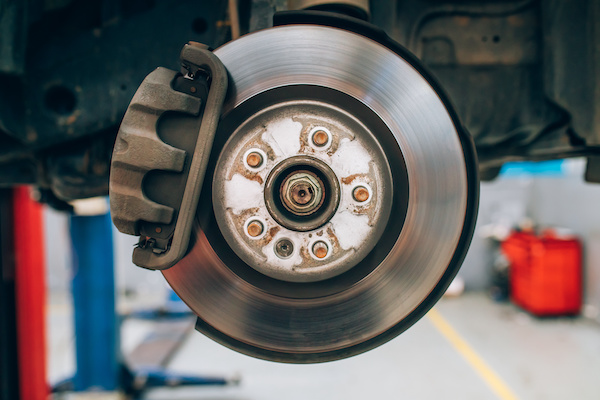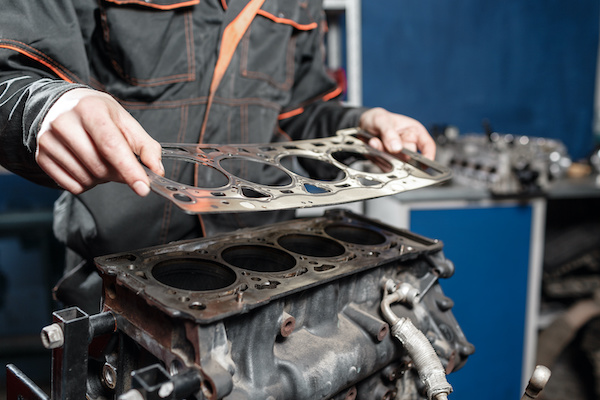Posted on 7/21/2021

Brake failure can cause horrific vehicle accidents, which is why we stress regular brake checks, maintenance, and repair. Your brakes must always be well-functioning. As a necessary car component, there have been significant advancements in the braking system over the years with the development of new technologies. The most prominent types of brakes today are drum and disc brakes, which differ significantly. Drum Brakes Although drum brakes still exist in some cars today, they are older versions of brakes that feature a simplistic design with low manufacturing costs. They are primarily made from cast iron and function by forcing the two arched shoes placed within the drum. Whenever the driver presses the brake pedal, brake fluid is pushed into the drum brake constraining the pistons to press against the drum surfaces. The interference results in the slow spinning of the wheels and eventually brings the car to a complete stop. Disc Brakes Disc brakes are advanced bra ... read more
Posted on 6/23/2021
.jpeg)
Visible corrosion is one of the common signs of battery terminal problems. It can interfere with the free flow of power within the battery and, in worst cases, block it altogether. Mostly, the corrosion appears like a white, bluish, or green substance on your car battery cables, posts, or terminals. The white-colored substance you observe can either be anhydrous copper sulfate or lead sulfate. Suffice to say, the former will eventually turn blue once exposed to moisture. The corrosion on your battery is a poor electrical conductor and tends to increase the resistance in the circuit. If not timely repaired, the resistance translates to transient current flow, which will ultimately prevent your car from starting. So, What Causes Battery Corrosion? Ideally, battery corrosion results from the hydrogen gas released by sulfuric acid present within the battery. As the gasses react with the ambient atmosphere, such elements as salts and moistures act as catalysts, speeding the process. The r ... read more
Posted on 5/19/2021
.jpeg)
For all of the advances in vehicle technology and performance, keeping track of all necessary maintenance and repair work can be difficult. One of the most critical conditions for driving your car safely and happily is proper wheel alignment. Regrettably, it is perhaps one of the most underappreciated. Many people suffer from the signs and symptoms of wheel misalignment, oblivious to the fact that it is a simple remedy. Here are five common indicators that your vehicle needs to be aligned. 1. The Steering Wheel Is Skewed To One Side. Your handlebars should be almost perfectly straight if you're going straight down a smooth, level lane. Depending on the crest of the lane, a small amount of variance is normally permitted, but the wheel should be balanced and straight, and the vehicle's emblem in the center of the steering level should resemble you. It's time for an alignment if the wheel is more than a few degrees off-center in either direction. This will return the steerin ... read more
Posted on 4/23/2021
.jpeg)
It is important to know how your car 'feels'. A lot of damage and many engine problems can be avoided if you are 'in tune' with your vehicle. A bumpy feeling when you are driving could be attributed to many different things from suspension problems to worn-out tires and even problems with your steering column. Worn shocks are one of the chief reasons for a 'bumpy' feeling when you are driving. They can also cause the car to shake while driving, which could be an indication that the shocks or the struts are worn out. This causes tires to form bubbles or pockets where there should be tread and to wear the tread down considerably, in turn causing the vehicle to drive unevenly on the road. Further problems related to tires and a bumpy ride would be if the tires are either overinflated or underinflated and when wheels are misaligned or not secured correctly. Due to any of these problems, over a period of time, it will be noticeable when you are driving your car, an ... read more
Posted on 3/17/2021

A head gasket is a ringed panel that comes between the engine block and cylinder head. It works by acting as a barrier to prevent engine fluid from leaking into its cylinders. It also blocks off water and oil conduits from getting mixed with the fuel. Unfortunately, the gasket head is located next to a hot section of the engine. If either the cylinder head or engine block expands from overheating, it causes the head gasket to fail. The engine may also experience detonation, damaging the fire rings or armors in the process. This event causes the cylinder pressure to leak past the fire rings and damage the head gasket. Symptoms of a Blown Head Gasket: 1. Overheating: Overheating happens when oil leaks into the coolant system, lowering its ability to cool off the car's engine. Most engines experience elevated temperatures, especially when driving at low speeds. 2. A mix-up of coolant and oil: The engine oil helps lubricate the moving parts. However, it leaks into ... read more